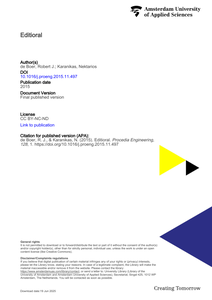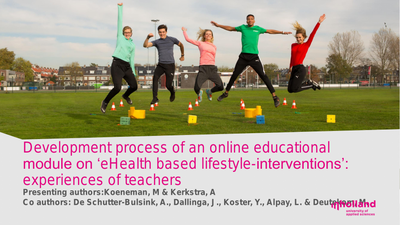A symbiotic relationship between human factors and safety scientists is needed to ensure the provision of holistic solutions for problems emerging in modern socio-technical systems. System Theoretic Accident Model and Processes (STAMP) tackles both interactions and individual failures of human and technological elements of systems. Human factors topics and indicative models, tools and methods were reviewed against the approach of STAMP. The results showed that STAMP engulfs many human factors subjects, is more descriptive than human factors models and tools, provides analytical power, and might be further improved by including more aspects of human factors. STAMP can serve in minimizing the gap between human factors and safety engineering sciences, which can collectively offer inclusive solutions to the industry.
DOCUMENT

Following the successful 3rd European STAMP Workshop in Amsterdam (5-6 October 2015), organised by the Aviation Academy of the Amsterdam University of Applied Sciences, we are pleased to present to the academic and professional community this special issue including 11 out of the 22 contributions to the workshop.
DOCUMENT

The Choices Programme is an internationally applicable nutrient profiling system with nutrition criteria for trans fatty acids (TFA), saturated fatty acids, sodium, added sugar and for some product groups energy and fibre. These criteria determine whether foods are eligible to carry a ‘‘healthier option’’ stamp. In this paper a nutrient intake modelling method is described to evaluate these nutritional criteria by investigating the potential effect on nutrient intakes.
LINK
Nutrient profiling is defined as the science of categorising foods based on their nutrient composition. The Choices Programme is a nutrient profile system with criteria that determine whether foods are eligible to carry a ‘‘healthier option’’ stamp. The Daily Menu Method which has been developed to evaluate these criteria is described here. This methodsimulates the change in calculated nutrient intakes which would be the result of consumers changing their diets in favour of food products that comply with the criteria.
LINK
Soft controls, in combinatie met hard controls, leiden tot een gewenste organisatiecultuur en voorkomen ongewenst gedrag. Maar hoe doet u dat: sturen op soft controls?
LINK
Deze workshop werd door Katja Braam en Joan Dallinga verzorgd op het Symposium 'Participatie Gezondheidsinnovatie'. In deze workshop werden deelnemers meegenomen in het ontwikkelingsproces van de online module die we met en voor Sportkundestudenten ontwikkelen. Hierin leren studenten een leefstijlinterventie te ontwikkelen waarin eHealth wordt gebruikt. Hoe hebben we dit gedaan, wat waren de uitdagingen en hoe ver zijn we nu? De conceptmodule werd getoond en deelnemers gingen aan de slag om de module aan te scherpen. Ook zijn ervaringen in andere opleidingen met ontwikkeling van eHealthonderwijs opeghaald.
DOCUMENT

It is a challenge for mathematics teachers to provide activities for their students at a high level of cognitive demand. In this article, we explore the possibilities that history of mathematics has to offer to meet this challenge. History of mathematics can be applied in mathematics education in different ways. We offer a framework for describing the appearances of history of mathematics in curriculum materials. This framework consists of four formats that are entitled speck, stamp, snippet, and story. Characteristic properties are named for each format, in terms of size, content, location, and function. The formats are related to four ascending levels of cognitive demand. We describe how these formats, together with design principles that are also derived from the history of mathematics, can be used to raise the cognitive level of existing tasks and design new tasks. The combination of formats, cognitive demand levels, and design principles is called the 4S-model. Finally, we advocate that this 4S-model can play a role in mathematics teacher training to enable prospective teachers to reach higher cognitive levels in their mathematics classrooms.
DOCUMENT

Development process of an online educational module on ‘eHealth based lifestyle-interventions’: experiences of teachers
DOCUMENT

Co-creation steps of an online educational module on eHealth for lifestyle improvement.
MULTIFILE
